Housing statistics quarterly update: June 2021
A summary of activity in new build housing and affordable housing in Scotland.
7. Affordable housing supply
Affordable Housing Supply Programme statistics reflect the broader supply of affordable homes (i.e. for social rent, affordable rent and affordable home ownership) and include off the shelf purchases and rehabilitations as well as new builds. Statistics are available up to the end of March 2021.
Quarterly affordable housing supply statistics are used to inform Scottish Government affordable housing delivery targets, including to deliver the remaining 50,000 target homes as quickly as it is safe to do so over the year 2021/22, along with the longer term ambition of delivering a further 100,000 affordable homes by 2032 with 70% of these being for social rent[5]. The figures reflect the number of affordable homes delivered that have received some form of government support through loans, grant or guarantees.
Approvals, starts and completions are all measured for the Affordable Housing Supply Programme. Approval is the point at which funding is granted. Starts are recorded when an on-site presence is established to progress site work. Completion measures when the units are delivered and ready for occupation.
Social Rent includes Housing Association Rent, Council House Rent as well as Home Owner Support Fund Rent.
Affordable Rent includes Mid-Market Rent (MMR), National Housing Trust (NHT) Rent as well as other programmes such as the Empty Homes Loan Fund (EHLF) and Rural Homes for Rent (RHfR).
Affordable Home Ownership includes Open Market Shared Equity (OMSE), New Supply Shared Equity (NSSE), Shared Ownership (LCHO) as well as other programmes such as Home Owner Support Fund Shared Equity.
Latest figures to end March 2021:
COVID-19 lockdown restrictions on construction and housing market activity from mid-March 2020 to late June 2020 have lowered the total amount of activity recorded for the two quarters from January to March 2020 and April to June 2020 compared to what would otherwise have been the case.
Following this, there has been a phased re-start of supply activity, in which the construction sector moved into Phase 4 of the Restart Plan in mid July 2020. This allowed for sites to work up to a steady state operation using physical distancing, barriers, or controlled close working with PPE, but in some cases may result in fewer workforce staff on site to ensure safe working and physical distancing. In addition to this, some work on new approvals may have been affected over this period by the furloughing of some social landlord and construction sector staff.
Since the easing of the COVID-19 lockdown restrictions towards the end of June 2020, the total amount of activity recorded for the three quarters between July to September 2020 and January to March 2021 have increased, although the levels achieved may have been affected by the phased re-start of supply activity. Table 6 and Charts 11a to 11c below help to illustrate these trends.
Table 6 below shows that in the latest quarter January to March 2021, 3,790 homes were approved, 4,818 homes were started, and 3,160 homes were completed. The levels of approvals and completions are 38% (2,279 homes) and 10% (333 homes) lower than in the same period in the prevous year, but starts have increased slightly by 1% (52 homes).
Latest annual figures also show decreases, with the number of homes approved, started and completed in the year to March 2021 falling by 39% (5,004 homes) to 7,882 approvals, 15% (1,846 homes) to 10,199 starts and 30% (2,830 homes) to 6,466 completions, compared with the year to end March 2020.
| Affordable housing supply homes |
Approvals |
Starts |
Completions |
|---|---|---|---|
| Quarter Jan to Mar 2015 |
3,155 |
1,806 |
2,798 |
| Quarter Jan to Mar 2016 |
3,708 |
2,783 |
2,147 |
| Quarter Jan to Mar 2017 |
5,023 |
3,705 |
2,245 |
| Quarter Jan to Mar 2018 |
6,428 |
3,206 |
3,318 |
| Quarter Jan to Mar 2019 |
5,013 |
3,693 |
3,698 |
| Quarter Jan to Mar 2020 |
6,069 |
4,766 |
3,493 |
| Quarter Jan to Mar 2021 |
3,790 |
4,818 |
3,160 |
| Change over latest year |
-2,279 |
+52 |
-333 |
| Change (%) over latest year |
-38% |
+1% |
-10% |
| Year to Mar 2015 |
6,297 |
6,641 |
7,069 |
| Year to Mar 2016 |
7,945 |
7,682 |
6,512 |
| Year to Mar 2017 |
10,361 |
9,393 |
7,444 |
| Year to Mar 2018 |
11,677 |
10,569 |
8,578 |
| Year to Mar 2019 |
11,130 |
10,872 |
9,569 |
| Year to Mar 2020 |
12,886 |
12,045 |
9,296 |
| Year to Mar 2021 |
7,882 |
10,199 |
6,466 |
| Change over latest year |
-5,004 |
-1,846 |
-2,830 |
| Change (%) over latest year |
-39% |
-15% |
-30% |
Chart 11a below illustrates the quarterly trends in the number of approvals since the beginning of 2018, and shows that 3,790 homes were approved in the latest quarter January to March 2021. This is 82% more (1,702 homes) approvals compared to the previous quarter, but is below equivalent January to March quarterly levels in each of the previous years 2018 to 2020.
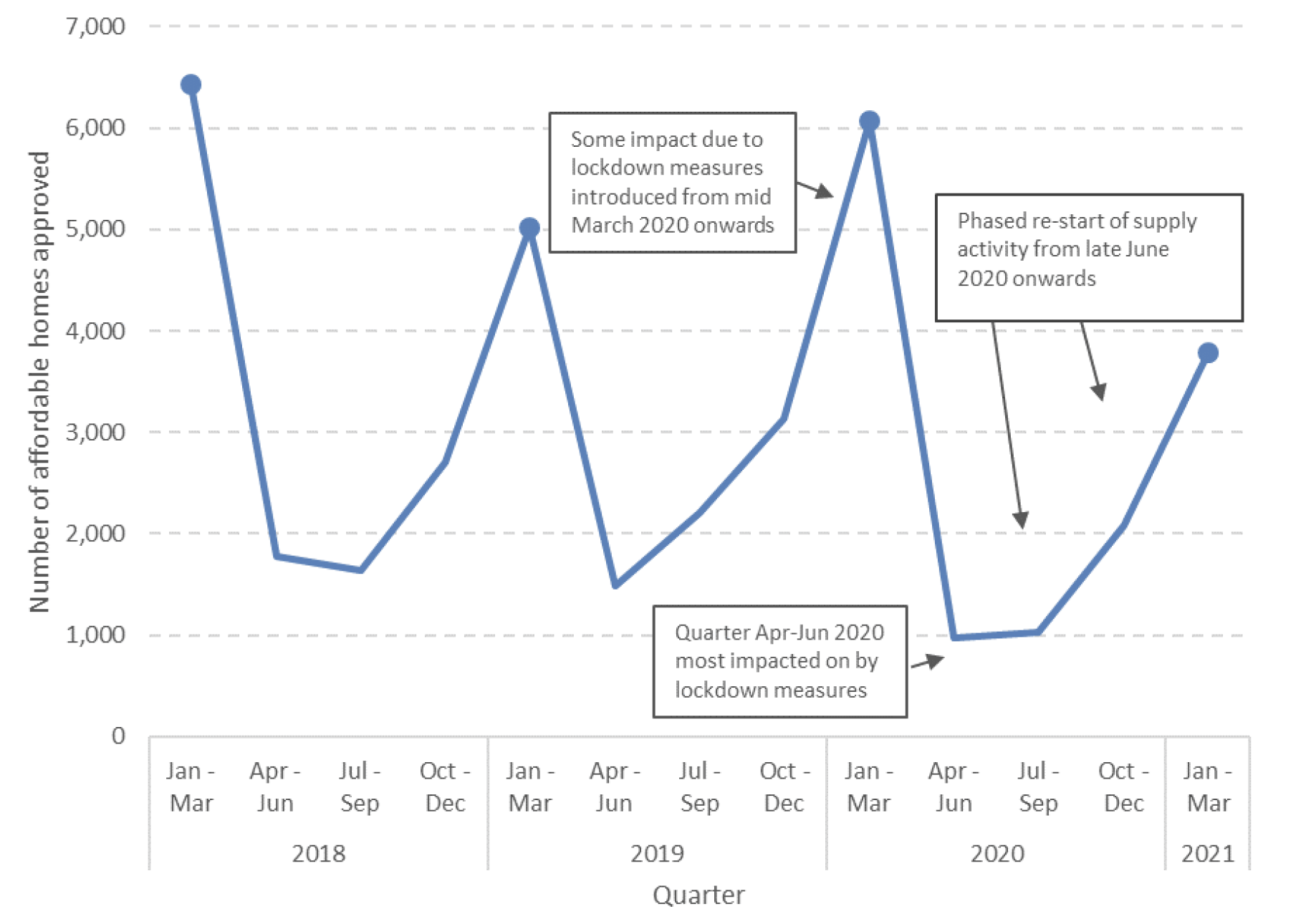
Chart 11b below shows the quarterly trends in the number of starts since the beginning of 2018, and shows that 4,818 homes were started in the latest quarter January to March 2021. This is over double (an increase of 2,549 homes) the number of starts in the previous quarter, and brings the level of starts above the equivalent January to March quarterly levels seen in each of the years 2018 to 2020.
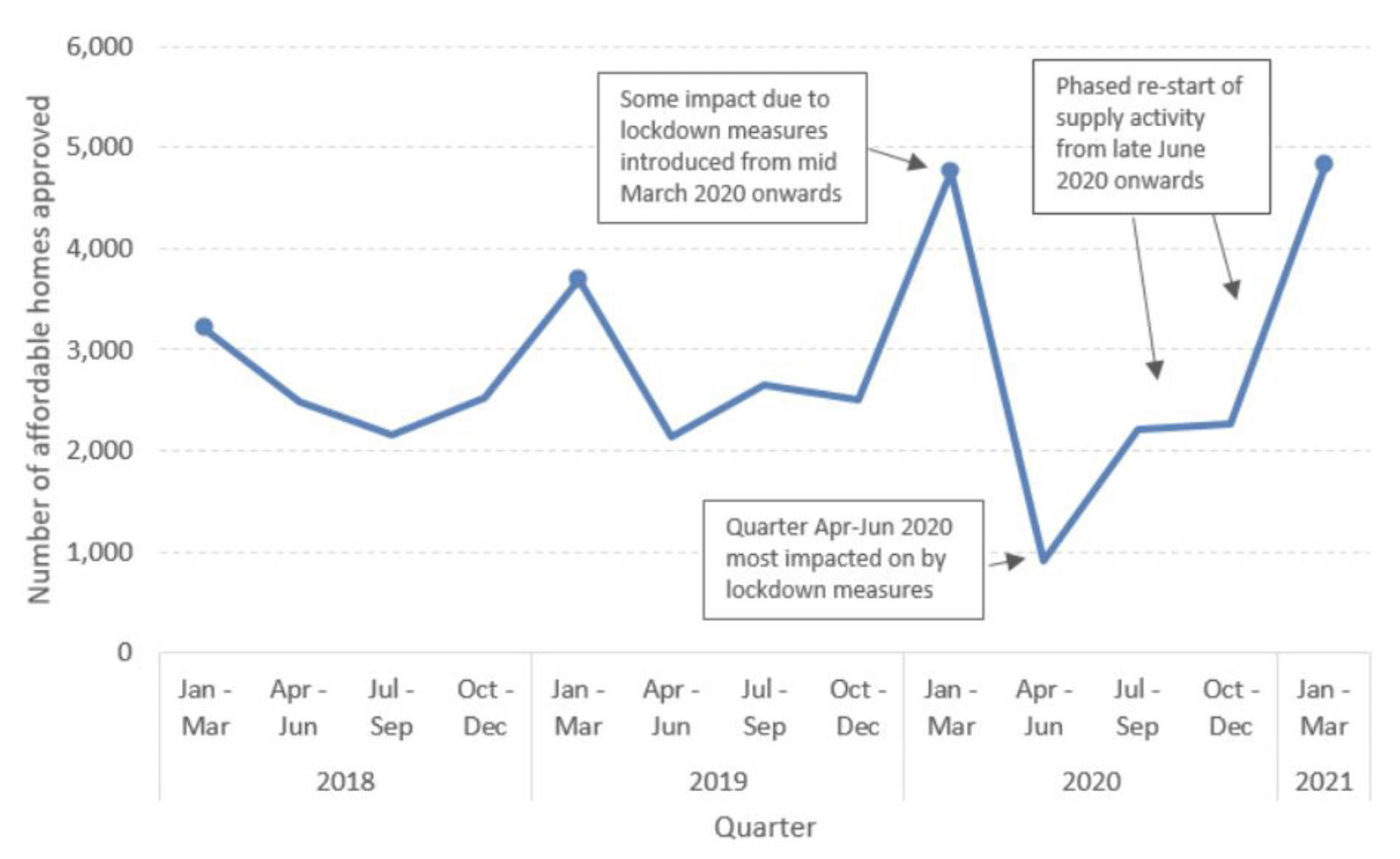
Chart 11c below illustrates the quarterly trends in the number of completions since the beginning of 2018, and shows that there were 3,160 affordable homes delivered in the latest quarter Jan-Mar 2021, an increase of 1,226 homes (63%) on the previous quarter, but 5% lower than in the same quarter in 2018, 15% lower than in 2019 and 10% lower than in 2020.
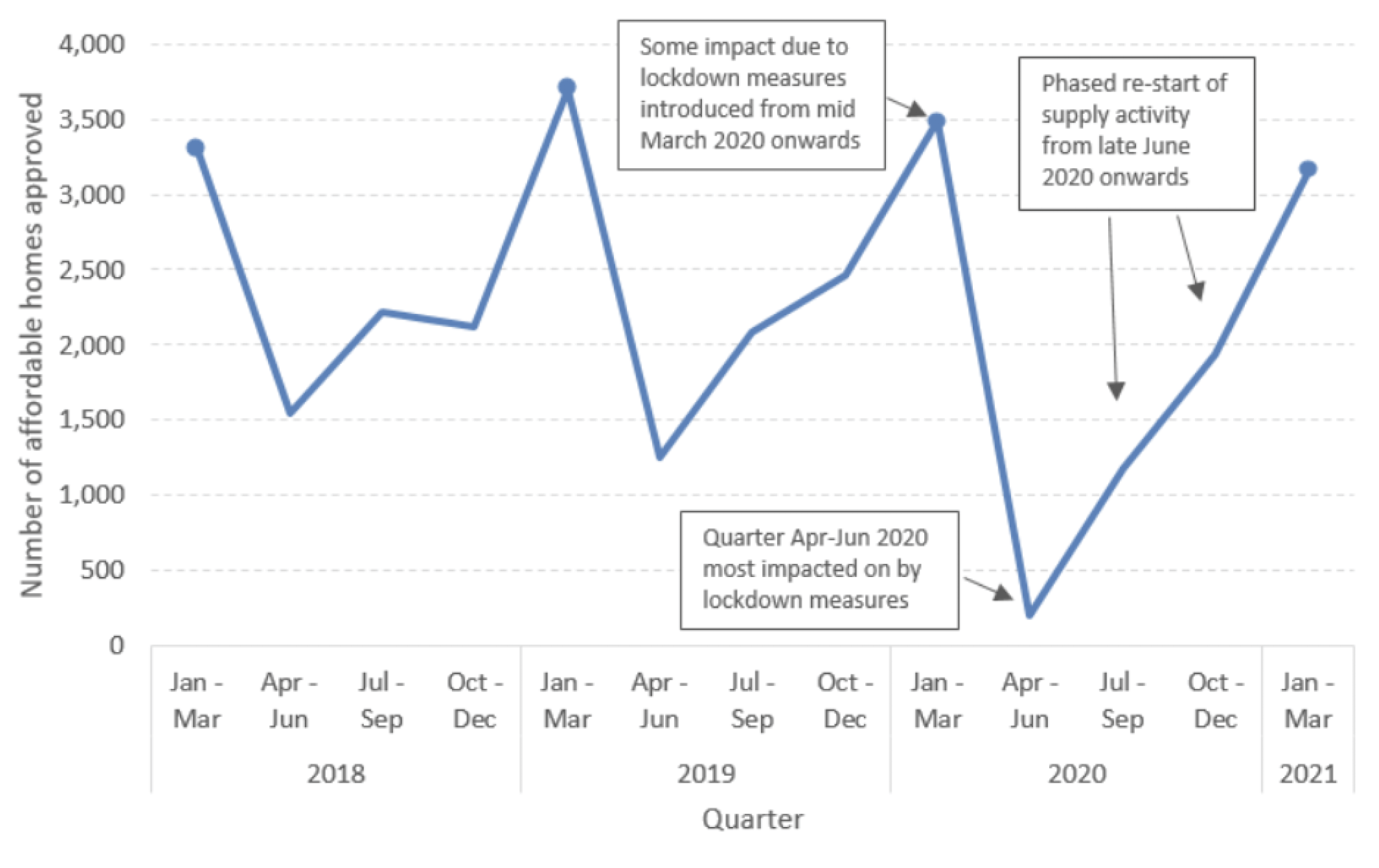
Chart 12 below shows that the numbers of homes approved, started and completed have all decreased on an annual basis over the latest year to end March 2021. In the year to end March 2021, 7,882 affordable homes were approved, a decrease of 5,004 homes (39%) on the previous year. 10,199 homes were started, a decrease of 1,846 homes (15%) on the previous year, and 6,466 affordable homes were completed, a decrease of 2,830 homes (30%) than in the previous year.
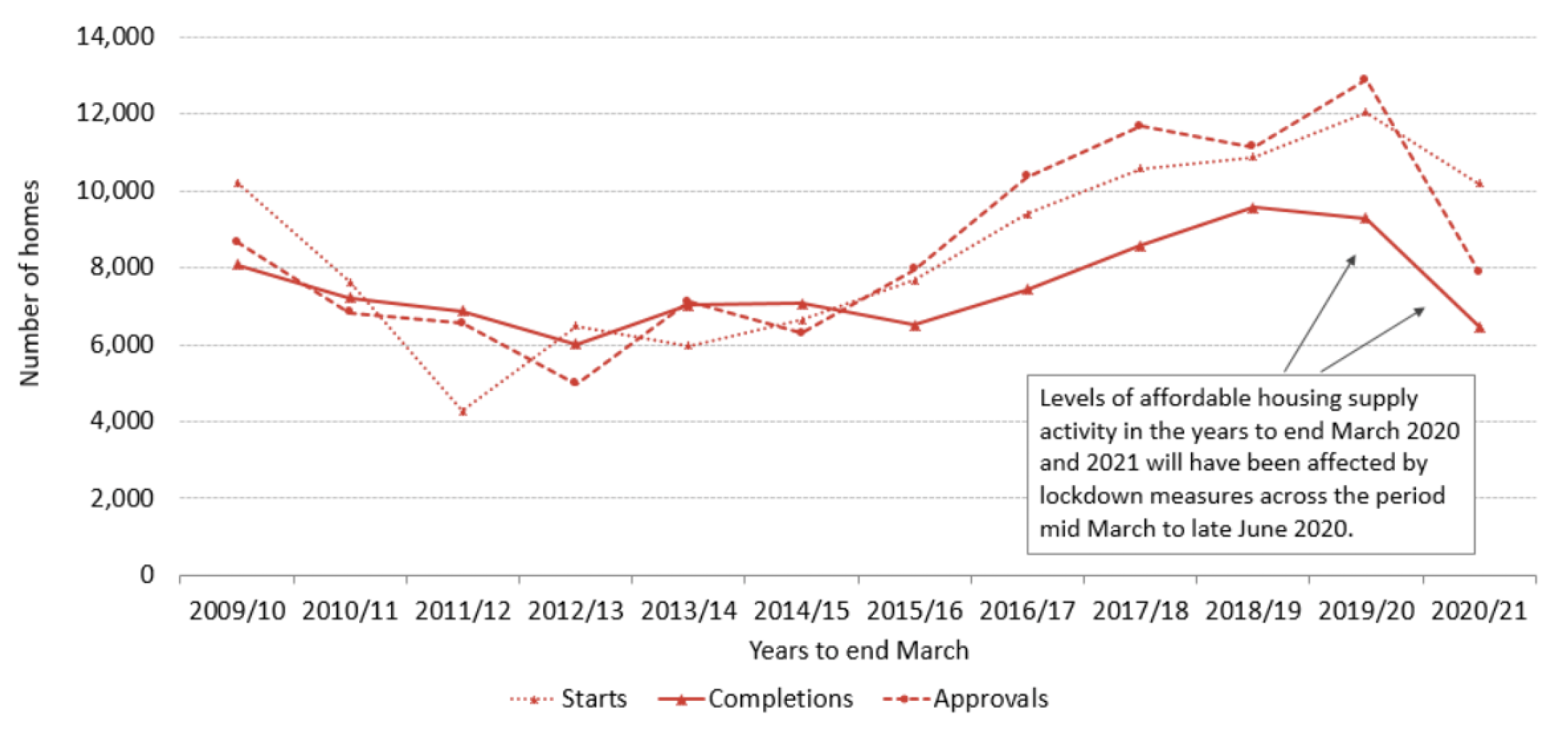
Charts 13 to 15 below present information on trends in affordable housing supply by type. Chart 13 shows that total affordable housing supply programme approvals decreased by 39% between 2020 and 2021 (years to end March). In the latest year 2021, social rent approvals accounted for 78% of all approvals, with affordable rent and affordable home ownership each making up 11% of the remaining total.
In the year to end March 2021, there were 6,164 homes approved for social rent, a decrease of 39% (3,893 homes) on the same period in 2020. There were 878 approvals for affordable rent, a decrease of 37% (519 homes) on the same period in 2020. 840 homes were approved for affordable home ownership in the year to end March 2021, a drop of 41% (592 homes) compared with the previous year.
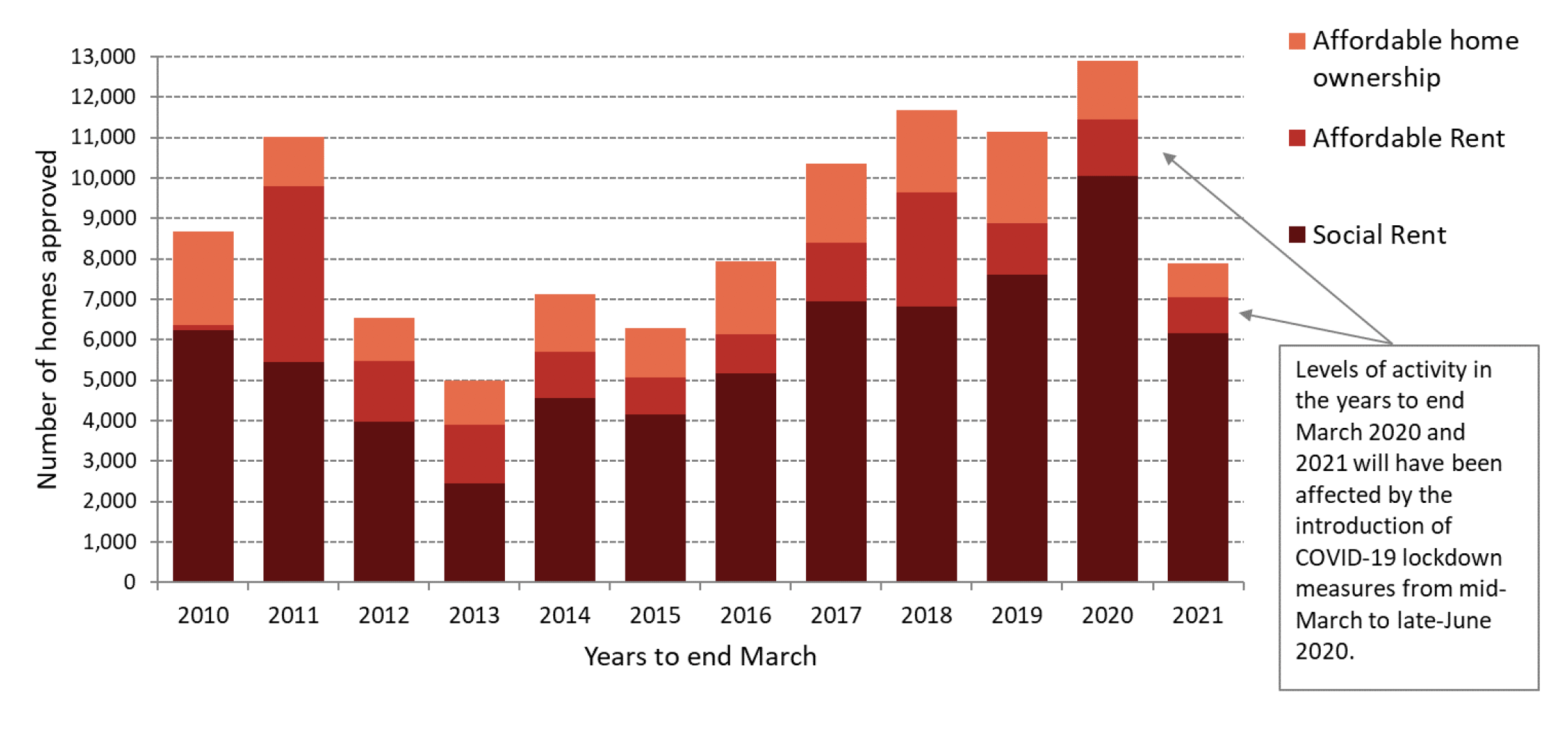
Chart 14 illustrates that total affordable housing supply programme starts decreased by 15% between 2020 and 2021 (years to end March). In the latest year, social rent starts accounted for 77% of all starts, with affordable rent and affordable home ownership making up 14% and 9% of the total, respectively.
In the year to end March 2021, there were 7,853 starts for social rent, a decrease of 11% (929 homes) than the previous year. There were 1,423 homes started for affordable rent in the year to end March 2021, a drop of 27% (539 homes) on the same period in 2020. In the year to end March 2021, 923 homes were started for affordable home ownership, a decrease of 29% (378 homes) than in the previous year.
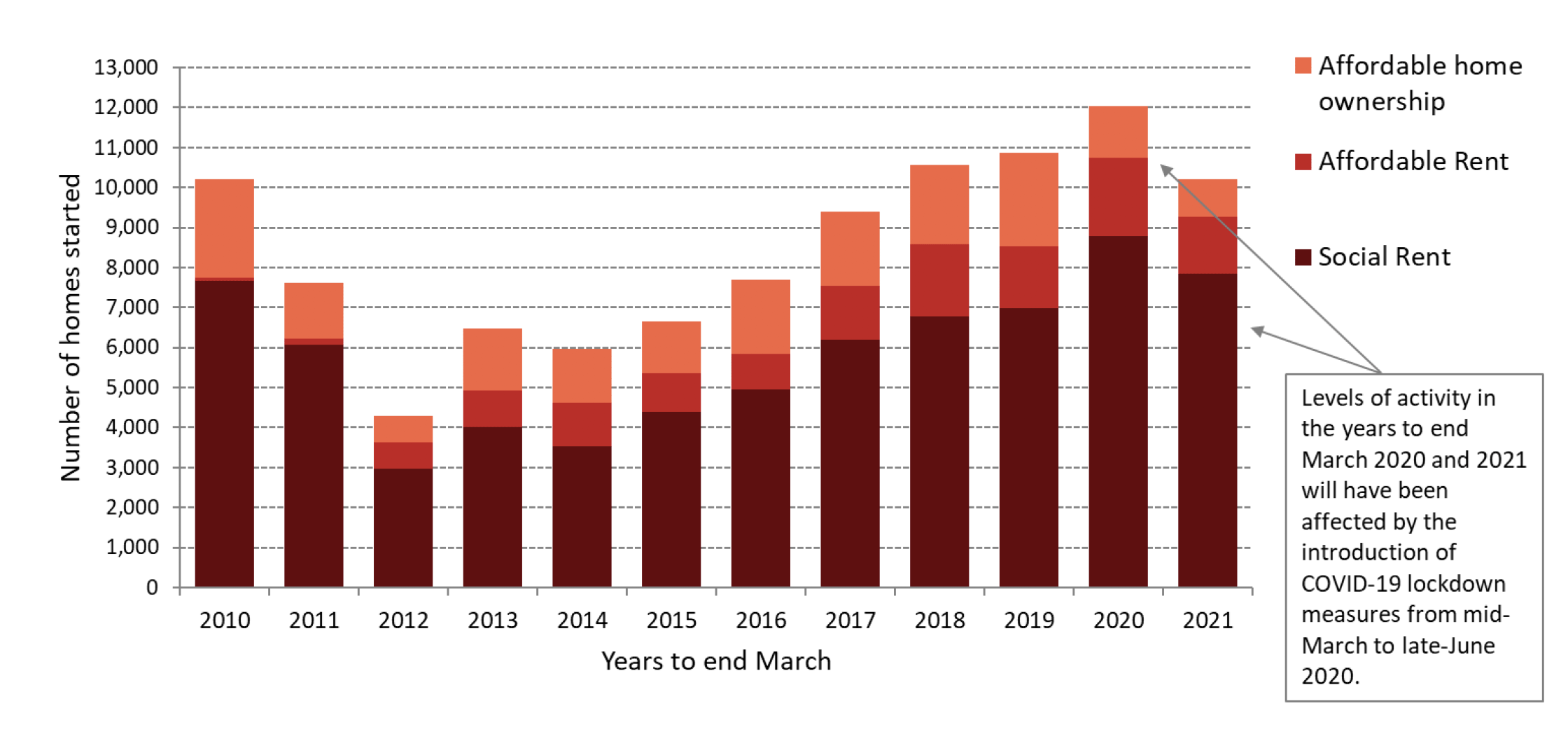
Chart 15 shows that total affordable housing supply programme completions decreased by 30% between 2020 and 2021 (years to end March). In the latest year, social rent completions accounted for 73% of all completions, with affordable rent and affordable home ownership making up 14% and 13% of the total, respectively.
In the year to end March 2021, there were 4,698 homes completed for social rent, a decrease of 33% (2,264 homes) than the previous year. There were 904 affordable rent homes completed in the year to end March 2021, a drop of 7% (63 homes) compared with 2020. A total of 864 homes were completed for affordable home ownership in the year to end March 2021, a decrease of 37% (503 homes) than in 2020.
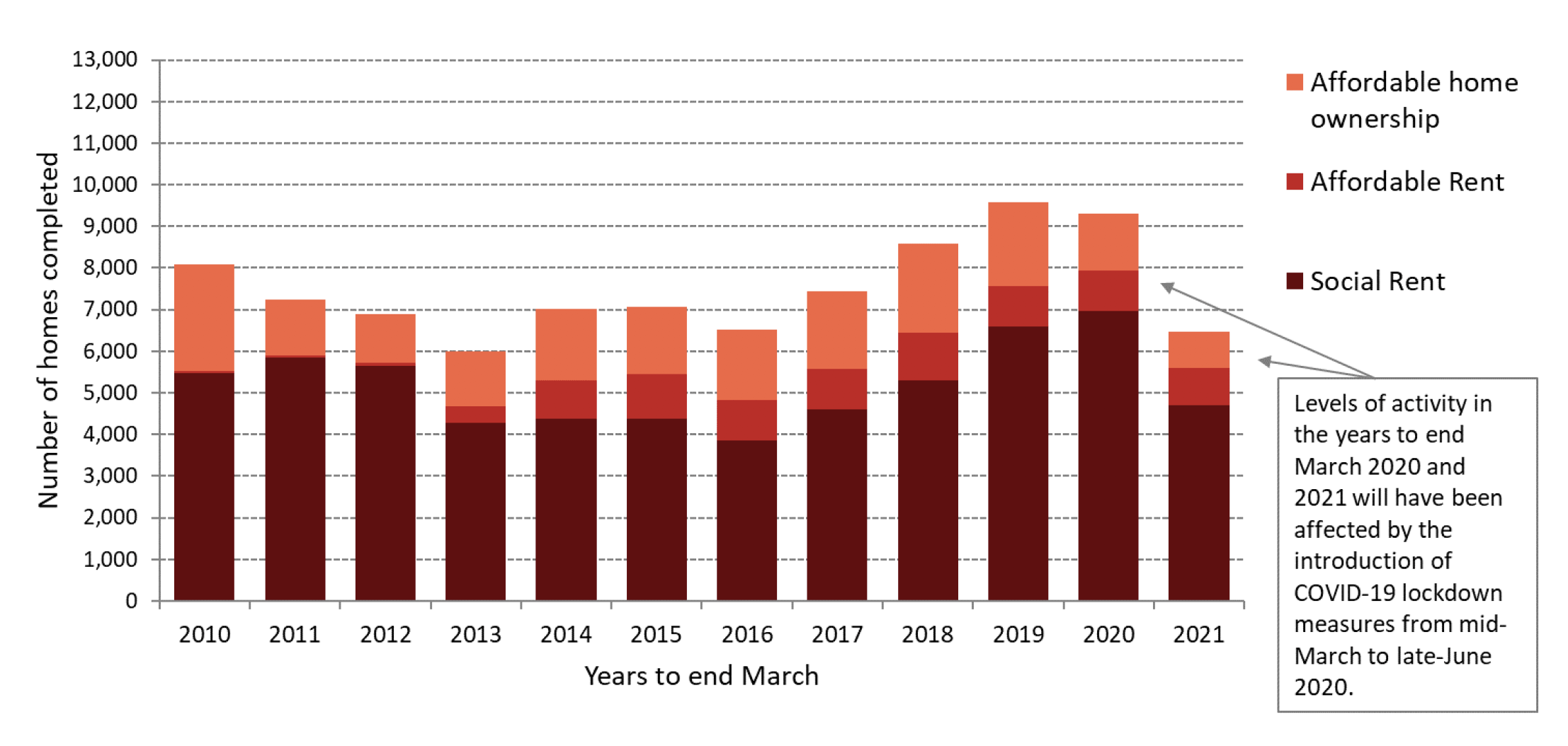
Comparison with the rest of the UK from 2007/08 to 2020/21
This section compares how the level of affordable housing supply per head of population varies between Scotland and other UK countries, to help meet user demand for cross country analysis.
Each of the countries of the UK produces their own statistics on affordable housing supply[6]. Whilst there are some differences in the detail of affordable housing definitions and products used by each country, some comparisons can be made on how affordable housing supply varies per head of population.
Chart 16 below illustrates how the figures per 10,000 population have varied across the 2007/08 to 2020/21 period for Scotland, England, Wales and Northern Ireland.
Between 2007/08 and 2019/20, the latest year in which there are figures available across all UK countries, the annual average supply of affordable housing per head of population in Scotland has been 13.8 homes per 10,000 population, higher than England (9.7 homes per 10,000 population), Wales (7.7 homes per 10,000 population), and Northern Ireland (13.0 homes per 10,000 population – average across the years 2010/11 to 2019/20). Scotland has had annual rates above all other UK countries in most years since 2007/08, except for during 2012/13 to 2014/15, in which the rates for Northern Ireland were higher.
The 9,296 affordable homes completed in Scotland in the financial year 2019/20 equates to a rate of 17.0 homes delivered per 10,000 population. This is above the rate of 10.2 in England and the rate of 9.3 in Wales and 14.4 in Northern Ireland[7].
The 6,466 affordable homes completed in in Scotland in the latest financial year 2020/21 equates to a rate of 11.8 homes delivered per 10,000 population, the lowest rate of homes delivered in Scotland since 2012/13, athough this figure will have been impacted by the lockdown measures in place from mid-March to late June 2020, along with the subsequent phased restart of supply activity.
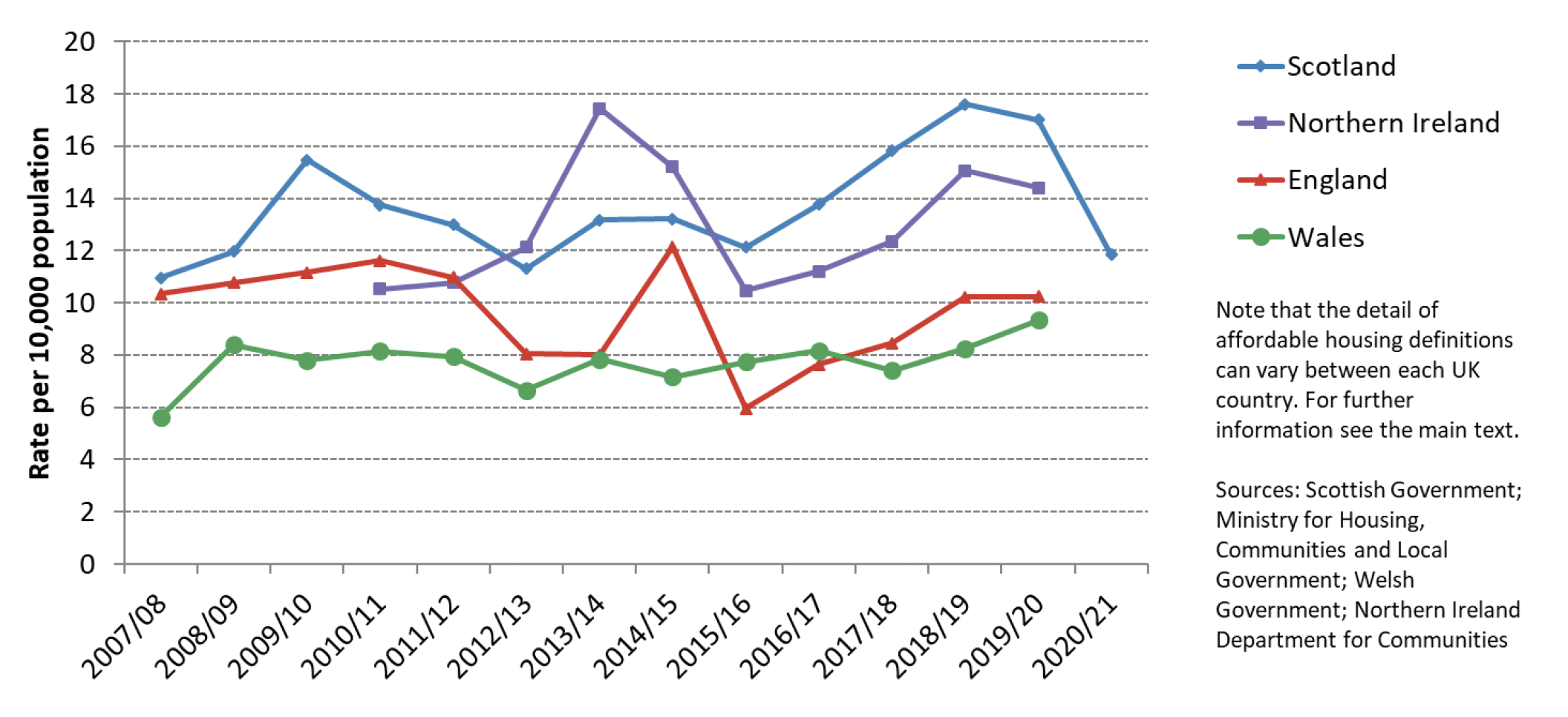
Affordable housing supply figures for 2020/21 for England, Wales and Northern Ireland are not yet available, however these will be added to Chart 16 in future publications when the figures are published.
Note that the statistics for England and Wales both include developer-funded Section 106 supply, although for England it is thought that some will be missed as local authorities are not aware of it all. Northern Ireland does not currently have an equivalent mechanism. Data for Scotland include Section 75 units receiving some form of government funding. Data are not available to estimate the number of affordable homes delivered without central government funding in Scotland, but it is thought that the numbers of these homes may be relatively low based on current estimates of the number of funded Affordable and Section 75 homes being delivered.
In addition to the differences in total affordable supply between each country, there are also some differences in the use of different affordable housing products within the mix of overall affordable housing in each country. For example, in England in recent years there has been a greater use of affordable / intermediate rent compared to social rent. Therefore when looking over the four years to 2019/20, in England there have been on average 5.0 affordable / intermediate rent homes completed per 10,000 head of population and 1.1 social rented homes completed 10,000 per-head of population. This compares to a rate of 1.9 for affordable rent homes and a rate of 10.8 for social rented homes in Scotland.
Contact
Email: housingstatistics@gov.scot
There is a problem
Thanks for your feedback